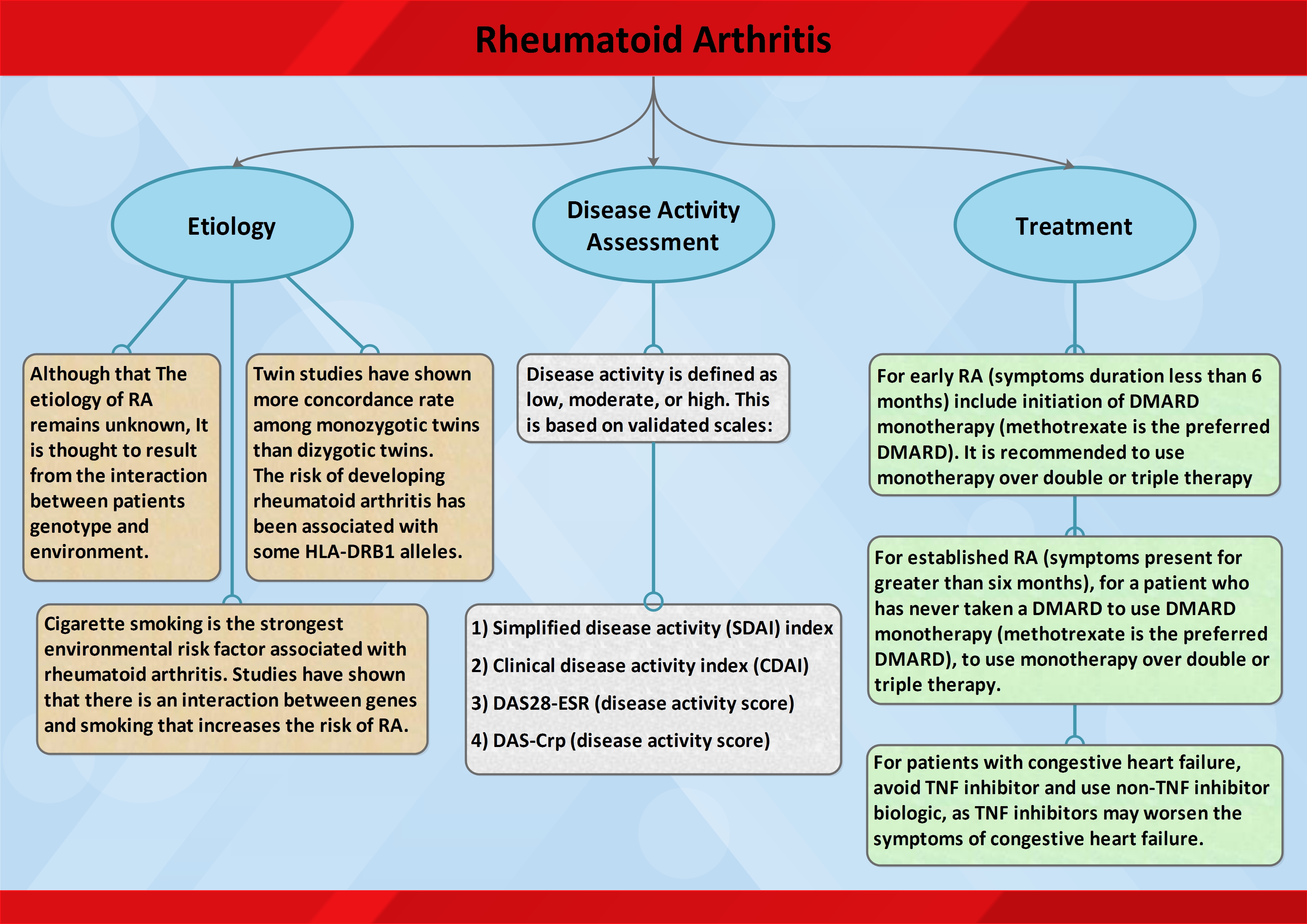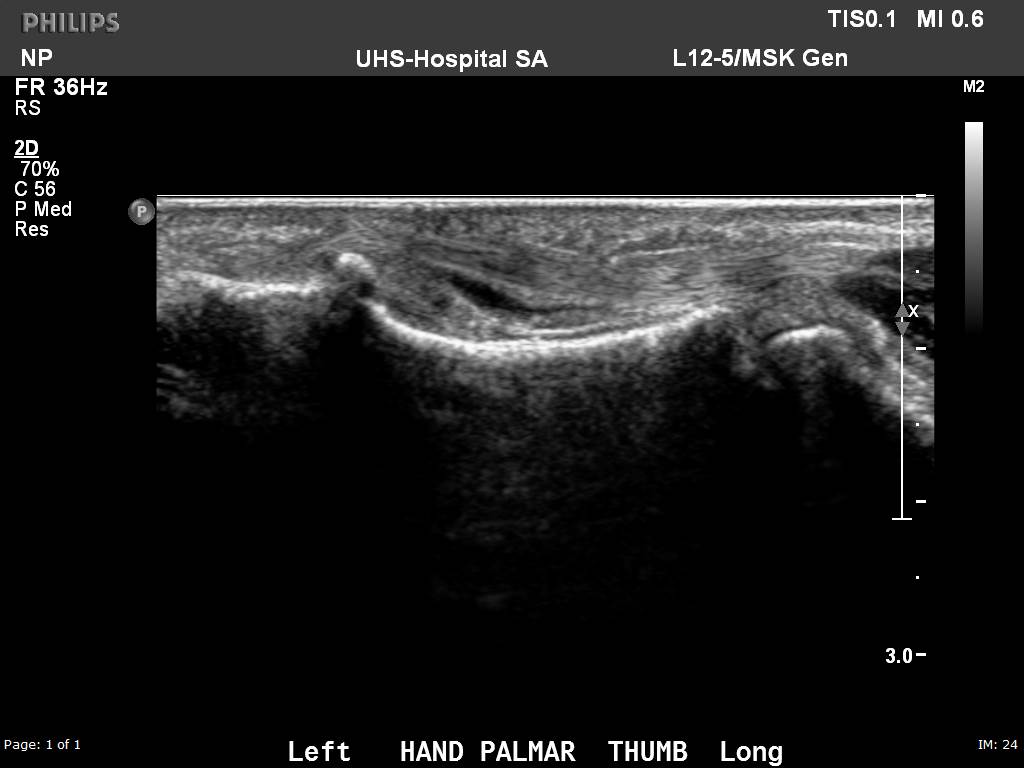[1]
Guo Q,Wang Y,Xu D,Nossent J,Pavlos NJ,Xu J, Rheumatoid arthritis: pathological mechanisms and modern pharmacologic therapies. Bone research. 2018;
[PubMed PMID: 29736302]
[2]
Cai Q,Xin Z,Zuo L,Li F,Liu B, Alzheimer's Disease and Rheumatoid Arthritis: A Mendelian Randomization Study. Frontiers in neuroscience. 2018;
[PubMed PMID: 30258348]
[3]
Carbone F,Bonaventura A,Liberale L,Paolino S,Torre F,Dallegri F,Montecucco F,Cutolo M, Atherosclerosis in Rheumatoid Arthritis: Promoters and Opponents. Clinical reviews in allergy
[PubMed PMID: 30259381]
[4]
Alamanos Y,Voulgari PV,Drosos AA, Incidence and prevalence of rheumatoid arthritis, based on the 1987 American College of Rheumatology criteria: a systematic review. Seminars in arthritis and rheumatism. 2006 Dec
[PubMed PMID: 17045630]
Level 1 (high-level) evidence
[6]
Nielen MM,van Schaardenburg D,Reesink HW,van de Stadt RJ,van der Horst-Bruinsma IE,de Koning MH,Habibuw MR,Vandenbroucke JP,Dijkmans BA, Specific autoantibodies precede the symptoms of rheumatoid arthritis: a study of serial measurements in blood donors. Arthritis and rheumatism. 2004 Feb
[PubMed PMID: 14872479]
[9]
Smeets TJ,Dolhain RJ,Breedveld FC,Tak PP, Analysis of the cellular infiltrates and expression of cytokines in synovial tissue from patients with rheumatoid arthritis and reactive arthritis. The Journal of pathology. 1998 Sep
[PubMed PMID: 9875143]
[10]
Deane KD,Norris JM,Holers VM, Preclinical rheumatoid arthritis: identification, evaluation, and future directions for investigation. Rheumatic diseases clinics of North America. 2010 May
[PubMed PMID: 20510231]
Level 3 (low-level) evidence
[11]
Gerlag DM,Raza K,van Baarsen LG,Brouwer E,Buckley CD,Burmester GR,Gabay C,Catrina AI,Cope AP,Cornelis F,Dahlqvist SR,Emery P,Eyre S,Finckh A,Gay S,Hazes JM,van der Helm-van Mil A,Huizinga TW,Klareskog L,Kvien TK,Lewis C,Machold KP,Rönnelid J,van Schaardenburg D,Schett G,Smolen JS,Thomas S,Worthington J,Tak PP, EULAR recommendations for terminology and research in individuals at risk of rheumatoid arthritis: report from the Study Group for Risk Factors for Rheumatoid Arthritis. Annals of the rheumatic diseases. 2012 May
[PubMed PMID: 22387728]
[12]
Fleming A,Crown JM,Corbett M, Early rheumatoid disease. I. Onset. Annals of the rheumatic diseases. 1976 Aug
[PubMed PMID: 970994]
[13]
Smolen JS, Aletaha D, McInnes IB. Rheumatoid arthritis. Lancet (London, England). 2016 Oct 22:388(10055):2023-2038. doi: 10.1016/S0140-6736(16)30173-8. Epub 2016 May 3
[PubMed PMID: 27156434]
[15]
Smolen JS,Aletaha D,Barton A,Burmester GR,Emery P,Firestein GS,Kavanaugh A,McInnes IB,Solomon DH,Strand V,Yamamoto K, Rheumatoid arthritis. Nature reviews. Disease primers. 2018 Feb 8;
[PubMed PMID: 29417936]
[16]
Marinou I,Maxwell JR,Wilson AG, Genetic influences modulating the radiological severity of rheumatoid arthritis. Annals of the rheumatic diseases. 2010 Mar;
[PubMed PMID: 20124360]
[17]
van Leeuwen MA,van Rijswijk MH,van der Heijde DM,Te Meerman GJ,van Riel PL,Houtman PM,van De Putte LB,Limburg PC, The acute-phase response in relation to radiographic progression in early rheumatoid arthritis: a prospective study during the first three years of the disease. British journal of rheumatology. 1993 Jun;
[PubMed PMID: 8508266]
[18]
Rantapää-Dahlqvist S,de Jong BA,Berglin E,Hallmans G,Wadell G,Stenlund H,Sundin U,van Venrooij WJ, Antibodies against cyclic citrullinated peptide and IgA rheumatoid factor predict the development of rheumatoid arthritis. Arthritis and rheumatism. 2003 Oct
[PubMed PMID: 14558078]
[19]
Klareskog L,Stolt P,Lundberg K,Källberg H,Bengtsson C,Grunewald J,Rönnelid J,Harris HE,Ulfgren AK,Rantapää-Dahlqvist S,Eklund A,Padyukov L,Alfredsson L, A new model for an etiology of rheumatoid arthritis: smoking may trigger HLA-DR (shared epitope)-restricted immune reactions to autoantigens modified by citrullination. Arthritis and rheumatism. 2006 Jan
[PubMed PMID: 16385494]
[20]
Cambridge G,Williams M,Leaker B,Corbett M,Smith CR, Anti-myeloperoxidase antibodies in patients with rheumatoid arthritis: prevalence, clinical correlates, and IgG subclass. Annals of the rheumatic diseases. 1994 Jan
[PubMed PMID: 8311550]
[21]
Tur BS,Süldür N,Ataman S,Tutkak H,Atay MB,Düzgün N, Anti-neutrophil cytoplasmic antibodies in patients with rheumatoid arthritis: clinical, biological, and radiological correlations. Joint bone spine. 2004 May
[PubMed PMID: 15182790]
[22]
Schett G,Gravallese E, Bone erosion in rheumatoid arthritis: mechanisms, diagnosis and treatment. Nature reviews. Rheumatology. 2012 Nov;
[PubMed PMID: 23007741]
[23]
Sahatçiu-Meka V,Rexhepi S,Manxhuka-Kërliu S,Rexhepi M, Radiographic estimation in seropositive and seronegative rheumatoid arthritis. Bosnian journal of basic medical sciences. 2011 Aug;
[PubMed PMID: 21875421]
[24]
Renner WR,Weinstein AS, Early changes of rheumatoid arthritis in the hand and wrist. Radiologic clinics of North America. 1988 Nov;
[PubMed PMID: 3051092]
[25]
Narváez JA,Narváez J,De Lama E,De Albert M, MR imaging of early rheumatoid arthritis. Radiographics : a review publication of the Radiological Society of North America, Inc. 2010 Jan;
[PubMed PMID: 20083591]
[26]
Arnett FC,Edworthy SM,Bloch DA,McShane DJ,Fries JF,Cooper NS,Healey LA,Kaplan SR,Liang MH,Luthra HS, The American Rheumatism Association 1987 revised criteria for the classification of rheumatoid arthritis. Arthritis and rheumatism. 1988 Mar
[PubMed PMID: 3358796]
[27]
Nelson PT,Saper CB, Ultrastructure of neurofibrillary tangles in the cerebral cortex of sheep. Neurobiology of aging. 1995 May-Jun
[PubMed PMID: 7566341]
[28]
Aletaha D,Neogi T,Silman AJ,Funovits J,Felson DT,Bingham CO 3rd,Birnbaum NS,Burmester GR,Bykerk VP,Cohen MD,Combe B,Costenbader KH,Dougados M,Emery P,Ferraccioli G,Hazes JM,Hobbs K,Huizinga TW,Kavanaugh A,Kay J,Kvien TK,Laing T,Mease P,Ménard HA,Moreland LW,Naden RL,Pincus T,Smolen JS,Stanislawska-Biernat E,Symmons D,Tak PP,Upchurch KS,Vencovský J,Wolfe F,Hawker G, 2010 Rheumatoid arthritis classification criteria: an American College of Rheumatology/European League Against Rheumatism collaborative initiative. Arthritis and rheumatism. 2010 Sep
[PubMed PMID: 20872595]
[29]
Britsemmer K,Ursum J,Gerritsen M,van Tuyl LH,van Schaardenburg D, Validation of the 2010 ACR/EULAR classification criteria for rheumatoid arthritis: slight improvement over the 1987 ACR criteria. Annals of the rheumatic diseases. 2011 Aug
[PubMed PMID: 21586440]
Level 1 (high-level) evidence
[30]
van der Linden MP,Knevel R,Huizinga TW,van der Helm-van Mil AH, Classification of rheumatoid arthritis: comparison of the 1987 American College of Rheumatology criteria and the 2010 American College of Rheumatology/European League Against Rheumatism criteria. Arthritis and rheumatism. 2011 Jan
[PubMed PMID: 20967854]
[32]
Wolfe F,Rehman Q,Lane NE,Kremer J, Starting a disease modifying antirheumatic drug or a biologic agent in rheumatoid arthritis: standards of practice for RA treatment. The Journal of rheumatology. 2001 Jul
[PubMed PMID: 11469485]
[33]
Korpela M,Laasonen L,Hannonen P,Kautiainen H,Leirisalo-Repo M,Hakala M,Paimela L,Blåfield H,Puolakka K,Möttönen T, Retardation of joint damage in patients with early rheumatoid arthritis by initial aggressive treatment with disease-modifying antirheumatic drugs: five-year experience from the FIN-RACo study. Arthritis and rheumatism. 2004 Jul
[PubMed PMID: 15248204]
[34]
Boers M,Verhoeven AC,Markusse HM,van de Laar MA,Westhovens R,van Denderen JC,van Zeben D,Dijkmans BA,Peeters AJ,Jacobs P,van den Brink HR,Schouten HJ,van der Heijde DM,Boonen A,van der Linden S, Randomised comparison of combined step-down prednisolone, methotrexate and sulphasalazine with sulphasalazine alone in early rheumatoid arthritis. Lancet (London, England). 1997 Aug 2
[PubMed PMID: 9251634]
Level 1 (high-level) evidence
[35]
Furst DE, Meloxicam: selective COX-2 inhibition in clinical practice. Seminars in arthritis and rheumatism. 1997 Jun;
[PubMed PMID: 9219316]
[36]
Quan L,Zhang Y,Crielaard BJ,Dusad A,Lele SM,Rijcken CJF,Metselaar JM,Kostková H,Etrych T,Ulbrich K,Kiessling F,Mikuls TR,Hennink WE,Storm G,Lammers T,Wang D, Nanomedicines for inflammatory arthritis: head-to-head comparison of glucocorticoid-containing polymers, micelles, and liposomes. ACS nano. 2014 Jan 28;
[PubMed PMID: 24341611]
[39]
Deighton C,Criswell LA, Recent advances in the genetics of rheumatoid arthritis. Current rheumatology reports. 2006 Oct;
[PubMed PMID: 16973114]
Level 3 (low-level) evidence
[40]
Gregori D,Giacovelli G,Minto C,Barbetta B,Gualtieri F,Azzolina D,Vaghi P,Rovati LC, Association of Pharmacological Treatments With Long-term Pain Control in Patients With Knee Osteoarthritis: A Systematic Review and Meta-analysis. JAMA. 2018 Dec 25;
[PubMed PMID: 30575881]
Level 1 (high-level) evidence
[42]
Abbasi M,Mousavi MJ,Jamalzehi S,Alimohammadi R,Bezvan MH,Mohammadi H,Aslani S, Strategies toward rheumatoid arthritis therapy; the old and the new. Journal of cellular physiology. 2019 Jul;
[PubMed PMID: 30536757]
[44]
Lian BS,Busmanis I,Lee HY, Relapsing Course of Sulfasalazine-Induced Drug Reaction with Eosinophilia and Systemic Symptoms (DRESS) Complicated by Alopecia Universalis and Vitiligo. Annals of the Academy of Medicine, Singapore. 2018 Nov;
[PubMed PMID: 30578426]
[48]
Köhler BM,Günther J,Kaudewitz D,Lorenz HM, Current Therapeutic Options in the Treatment of Rheumatoid Arthritis. Journal of clinical medicine. 2019 Jun 28;
[PubMed PMID: 31261785]
[49]
Breedveld FC,Dayer JM, Leflunomide: mode of action in the treatment of rheumatoid arthritis. Annals of the rheumatic diseases. 2000 Nov;
[PubMed PMID: 11053058]
[50]
Fraenkel L,Bathon JM,England BR,St Clair EW,Arayssi T,Carandang K,Deane KD,Genovese M,Huston KK,Kerr G,Kremer J,Nakamura MC,Russell LA,Singh JA,Smith BJ,Sparks JA,Venkatachalam S,Weinblatt ME,Al-Gibbawi M,Baker JF,Barbour KE,Barton JL,Cappelli L,Chamseddine F,George M,Johnson SR,Kahale L,Karam BS,Khamis AM,Navarro-Millán I,Mirza R,Schwab P,Singh N,Turgunbaev M,Turner AS,Yaacoub S,Akl EA, 2021 American College of Rheumatology Guideline for the Treatment of Rheumatoid Arthritis. Arthritis
[PubMed PMID: 34101376]
[51]
Azeez M,Clancy C,O'Dwyer T,Lahiff C,Wilson F,Cunnane G, Benefits of exercise in patients with rheumatoid arthritis: a randomized controlled trial of a patient-specific exercise programme. Clinical rheumatology. 2020 Feb 8;
[PubMed PMID: 32036584]
Level 1 (high-level) evidence
[52]
Hernández-Hernández MV,Díaz-González F, Role of physical activity in the management and assessment of rheumatoid arthritis patients. Reumatologia clinica. 2017 Jul - Aug;
[PubMed PMID: 27263964]
[53]
Dwivedi S,Testa EJ,Modest JM,Ibrahim Z,Gil JA, Surgical Management of Rheumatoid Arthritis of the Hand. Rhode Island medical journal (2013). 2020 May 1;
[PubMed PMID: 32357591]
[55]
Bastian H,Ziegeler K,Hermann KGA,Feist E, [Rheumatoid arthritis-mimics : When appearances are deceptive]. Zeitschrift fur Rheumatologie. 2019 Feb;
[PubMed PMID: 30191389]
[56]
Smolen JS,Landewé R,Breedveld FC,Buch M,Burmester G,Dougados M,Emery P,Gaujoux-Viala C,Gossec L,Nam J,Ramiro S,Winthrop K,de Wit M,Aletaha D,Betteridge N,Bijlsma JW,Boers M,Buttgereit F,Combe B,Cutolo M,Damjanov N,Hazes JM,Kouloumas M,Kvien TK,Mariette X,Pavelka K,van Riel PL,Rubbert-Roth A,Scholte-Voshaar M,Scott DL,Sokka-Isler T,Wong JB,van der Heijde D, EULAR recommendations for the management of rheumatoid arthritis with synthetic and biological disease-modifying antirheumatic drugs: 2013 update. Annals of the rheumatic diseases. 2014 Mar;
[PubMed PMID: 24161836]


